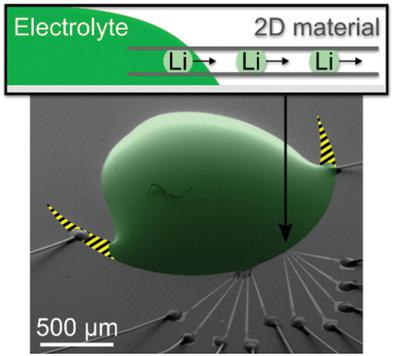当前位置:
X-MOL 学术
›
Adv. Mater. Interfaces
›
论文详情
Our official English website, www.x-mol.net, welcomes your
feedback! (Note: you will need to create a separate account there.)
Wettability Engineering for Studying Ion Transport in 2D Layered Materials
Advanced Materials Interfaces ( IF 4.3 ) Pub Date : 2020-11-25 , DOI: 10.1002/admi.202001453 Matthias Kühne 1 , Dong Zhao 1 , Ute Zschieschang 1 , Regina Buck 2 , Michaela Müller 2 , Hagen Klauk 1 , Jurgen H. Smet 1
Advanced Materials Interfaces ( IF 4.3 ) Pub Date : 2020-11-25 , DOI: 10.1002/admi.202001453 Matthias Kühne 1 , Dong Zhao 1 , Ute Zschieschang 1 , Regina Buck 2 , Michaela Müller 2 , Hagen Klauk 1 , Jurgen H. Smet 1
Affiliation

|
Layered materials are widely used for their capacity to incorporate and store foreign ionic species. It has become possible to exploit this process at the level of single crystals consisting of individual atomic layers: 2D materials and their van der Waals heterostructures. Due to the small size of available high‐quality specimen, however, it remains challenging to probe ion transport and storage in these systems. To promote future advances in this field, wettability engineering is introduced as a strategy for the on‐chip integration of electrolytes with micrometer‐sized samples of 2D materials. Contact angles are systematically measured for a variety of electrolyte–surface couples to identify a rational device design, and engineer lateral contrasts in surface chemistry to control the rims of drop cast electrolytes with micrometer precision. This allows covering single crystalline flakes of 2D materials only partially, leaving most of the sample surface uncovered and imposing directionality on ion transport. Wettability engineering is used to fabricate few‐layer graphene electrochemical micro two‐compartment cells that display chemical diffusion of lithium on the order of 10−8 cm2 s−1. While the approach is transferrable to other 2D materials and ionic species, it can also benefit device design for the study of nonlocal electrolyte gating effects.
中文翻译:

研究二维层状材料中离子迁移的润湿性工程
层状材料因其吸收和储存外来离子种类的能力而被广泛使用。在由单个原子层组成的单晶层面上可以利用此过程:2D材料及其范德华力异质结构。但是,由于可用的高质量标本的尺寸很小,因此在这些系统中探测离子的运输和存储仍然具有挑战性。为了促进该领域的未来发展,引入了润湿性工程技术,作为电解质与微米级二维材料样品在芯片上集成的一种策略。系统地测量了各种电解质-表面对的接触角,以确定合理的设备设计,并设计表面化学物质的横向对比,以千分尺精度控制滴铸电解质的边缘。这样可以仅部分覆盖2D材料的单晶薄片,而使大部分样品表面不被覆盖,并在离子传输中施加方向性。润湿性工程学用于制造几层石墨烯电化学微型两室电池,这些电池显示锂的化学扩散量约为10-8 cm 2 s -1。尽管该方法可以转移到其他2D材料和离子物种,但它也可以用于研究非局部电解质浇注效应的设备设计。
更新日期:2020-11-25
中文翻译:

研究二维层状材料中离子迁移的润湿性工程
层状材料因其吸收和储存外来离子种类的能力而被广泛使用。在由单个原子层组成的单晶层面上可以利用此过程:2D材料及其范德华力异质结构。但是,由于可用的高质量标本的尺寸很小,因此在这些系统中探测离子的运输和存储仍然具有挑战性。为了促进该领域的未来发展,引入了润湿性工程技术,作为电解质与微米级二维材料样品在芯片上集成的一种策略。系统地测量了各种电解质-表面对的接触角,以确定合理的设备设计,并设计表面化学物质的横向对比,以千分尺精度控制滴铸电解质的边缘。这样可以仅部分覆盖2D材料的单晶薄片,而使大部分样品表面不被覆盖,并在离子传输中施加方向性。润湿性工程学用于制造几层石墨烯电化学微型两室电池,这些电池显示锂的化学扩散量约为10-8 cm 2 s -1。尽管该方法可以转移到其他2D材料和离子物种,但它也可以用于研究非局部电解质浇注效应的设备设计。











































 京公网安备 11010802027423号
京公网安备 11010802027423号